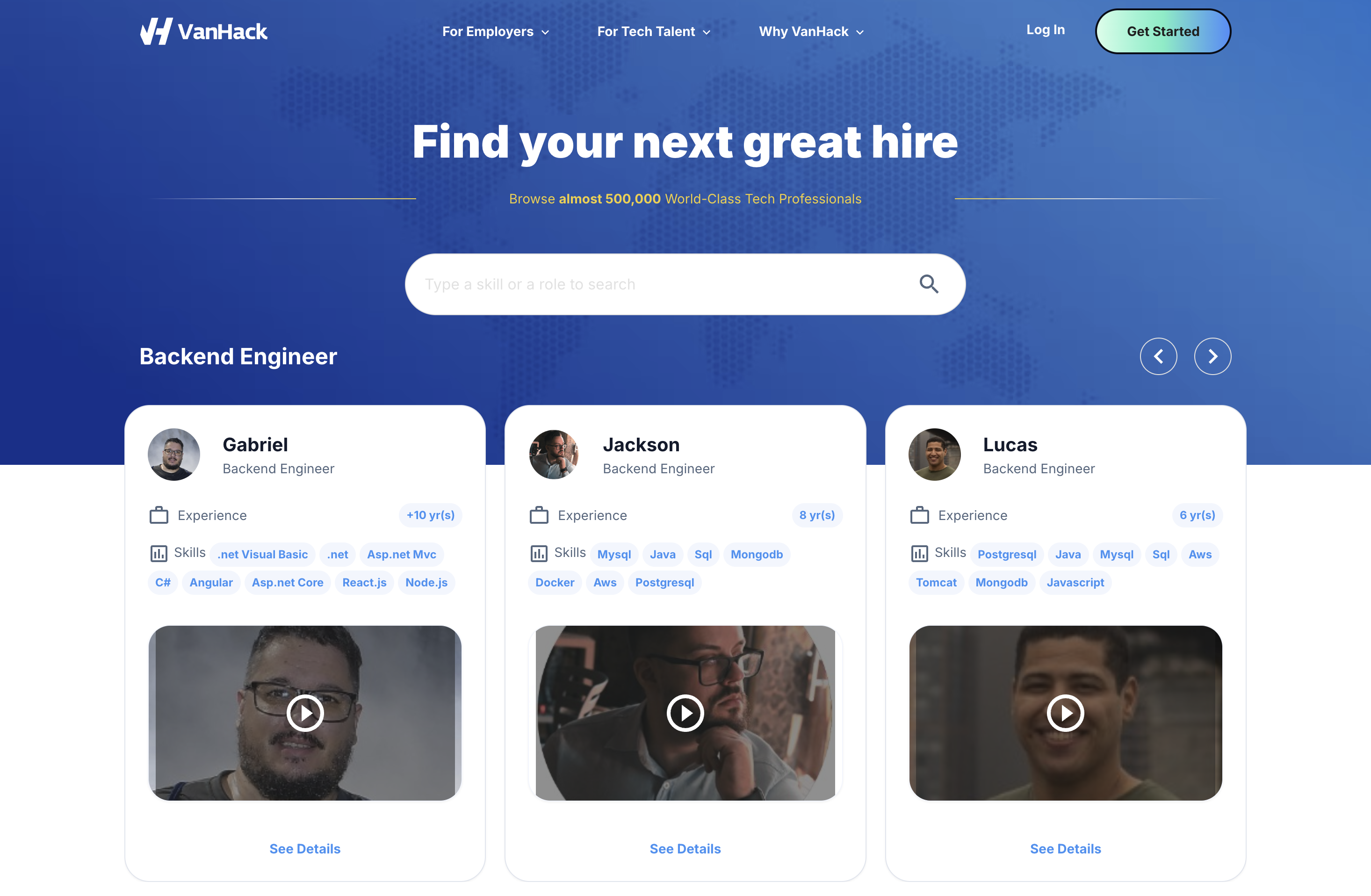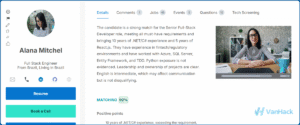US companies seeking remote developer talent in Latin America need a strong virtual interview process to succeed. This guide offers practical tips, tools, and strategies to create an effective and engaging experience for both hiring teams and candidates. With the right approach, you can confidently secure top LATAM talent for your engineering needs. Discover skilled developers with VanHack now.
Why Virtual Interviews Matter for Hiring LATAM Talent
Key Benefits of Targeting Latin American Developers
Latin America stands out as a valuable source of software engineering talent for US companies. Senior developers in countries like Mexico, Colombia, Argentina, and Brazil often earn 40-60% less than US counterparts while offering similar or even stronger technical skills.
Time zone alignment is a major plus. Most LATAM developers work within 1-3 hours of US time zones, making real-time collaboration and communication during standard business hours straightforward, unlike talent pools in Eastern Europe or Asia.
The technical expertise in the region is notable. Many LATAM developers hold degrees from respected universities and bring deep experience in modern frameworks, cloud solutions, and agile practices. Countries like Argentina and Brazil support thriving tech ecosystems that consistently produce high-quality professionals.
Cultural alignment also plays a role. Many developers in LATAM share similar business practices and communication styles with US teams, easing remote collaboration and strengthening team dynamics over time.
Navigating Challenges in Remote LATAM Hiring
Hiring remote LATAM developers comes with specific hurdles that require careful planning. English proficiency varies across the region. While many have a solid grasp of technical terms, complex business discussions or detailed technical explanations may need extra evaluation.
Communication styles can differ. In many LATAM cultures, building relationships often takes priority, and direct feedback or conflict resolution may be handled differently than in the US. Recognizing these differences helps avoid misunderstandings during interviews and beyond.
Assessing technical skills remotely adds complexity. Evaluating coding abilities, system design, and problem-solving through virtual tools demands advanced platforms and adapted methods to ensure accurate results.
Legal and logistical issues also arise. Employment laws, tax rules, and compliance vary by country, often requiring specialized knowledge or external partnerships to manage effectively.
Setting Up for Success: Pre-Interview Steps and Tools
Clarifying Technical and Cultural Needs for Remote Roles
Effective virtual interviews start with clear role definitions tailored for remote work. Beyond basic coding skills, look for abilities like independent problem-solving, asynchronous communication, and experience in distributed team setups. Senior roles should show strengths in code reviews, architectural decisions, and mentoring via virtual tools.
Cultural expectations are just as important. Ideal candidates proactively communicate, clarify tasks, report progress, and flag issues early. They should adapt to US business norms while bringing diverse perspectives to enrich team innovation.
Define communication needs upfront. Specify the level of English needed for technical discussions versus daily updates to avoid mismatched expectations with candidates.
Documentation skills matter in remote settings. Look for candidates who can create clear technical guides, contribute to shared resources, and support knowledge sharing across teams, ensuring smooth collaboration despite distance.
Choosing the Right Virtual Interview Tools
The tools you use for virtual interviews directly affect the quality of your assessments. Opt for platforms that blend video conferencing, technical testing, and evaluation features. Ensure they match your company’s size, needs, and budget while performing reliably across regions.
Tools like Codility, HackerRank, and CodeInterview provide specialized environments for coding tests. They offer real-time coding spaces, automated scoring, and features to mimic in-person assessments while ensuring fairness.
Video conferencing must be dependable, especially with varying internet quality in LATAM. Choose platforms with adaptive streaming, backup options, and mobile support. Recording features help with post-interview reviews and team collaboration.
Integration with your existing HR systems saves time. Platforms that sync candidate data, interview feedback, and results reduce manual work and help keep the hiring process organized.
Technical Interview Platform Comparison
|
Feature |
VanHack (Integrated) |
Codility |
HackerRank |
BarRaiser |
|
Real-time Coding |
Yes |
Yes |
Yes |
No |
|
AI Scoring |
Yes |
No |
Yes |
Yes |
|
Video Interviewing |
Yes |
No |
No |
Yes |
|
Custom Questions |
Yes |
Yes |
Yes |
Yes |
Designing Fair and Relevant Technical Assessments
Remote technical tests need to balance thorough evaluation with a positive candidate experience. Take-home challenges let candidates work in familiar settings and give you detailed code samples to review. Make these tasks mirror real job scenarios with relevant tools and systems.
Live coding sessions show how candidates solve problems and communicate under pressure. Platforms like HackerRank and CodeSignal offer real-time coding and collaboration features to support this effectively.
Adjust task difficulty based on experience level. Junior candidates can handle basic coding problems, while senior developers should address system design, trade-offs, and debugging. For top roles, include mentoring simulations to assess leadership.
Set clear evaluation standards. Use rubrics for code quality, problem-solving, communication, and technical depth to ensure consistent and fair scoring across all candidates.
Your Guide to the Virtual Interview Process for LATAM Developers
Stage 1: Early Screening for Communication and Fit
The first step in hiring remote LATAM developers focuses on communication skills and cultural fit. Assess English proficiency early to confirm candidates can engage in technical talks and team interactions. Video introductions offer a quick look at their style and professionalism.
Use structured calls to evaluate language skills, ability to explain technical ideas, and active listening. These qualities often predict success in remote teams more than pure technical ability.
Evaluate cultural fit by looking for adaptability, proactive updates, and comfort with unclear tasks. Candidates should show interest in US market trends and flexibility with time zones or remote work norms.
Asynchronous video responses to set questions can speed up screening. This method lets hiring teams review multiple candidates efficiently while giving applicants flexibility. Connect with pre-vetted talent through VanHack to streamline this step with ready-to-view video intros.
Stage 2: Deep Technical Evaluation Online
Technical interviews are the core of assessing LATAM developers. They reveal coding skills, problem-solving methods, and how well candidates explain their work. Use collaborative platforms for live coding to observe their approach in real-time.
Adapt system design interviews for virtual settings with tools that support diagrams and discussions. Focus on how candidates explain design choices, handle scalability, and balance different options.
AI tools can improve fairness in evaluations. Options like BarRaiser provide real-time scoring and question ideas to maintain consistency across interviews.
Structure interviews to progress from basic coding tasks to complex scenarios. Start with algorithms, move to debugging, and end with system design. This flow helps assess a wide range of skills thoroughly.
Ensure fairness with proctoring features. Platforms with tracking for copy-paste or tab-switching help maintain integrity while respecting candidate comfort. Be transparent about monitoring to build trust.
Stage 3: Evaluating Behavioral Skills and Cultural Fit
Behavioral interviews for LATAM developers need tailored questions to assess skills vital for remote success. Explore their experience with virtual teamwork, conflict handling, and staying productive independently.
Go beyond language to assess cross-cultural communication. Look for awareness of how their style might be interpreted and their ability to adjust for different audiences or team settings.
Use situational questions based on real remote work challenges, like managing time zone differences or resolving technical disputes online. These reveal practical adaptability and problem-solving.
Assess team integration by discussing how they build connections remotely, join virtual team activities, and support a positive culture. Look for proactive efforts to engage with colleagues.
Stage 4: Final Evaluation and Hiring Choices
Structured feedback after interviews ensures fair assessment and team alignment. Use forms to record scores and detailed notes on technical skills, communication, fit, and overall potential for the role.
Rely on data to make decisions. Weighted scoring prioritizes key skills for the position, balancing technical ability with communication and cultural alignment.
Hold debrief meetings with all interviewers via video to share insights and agree on candidates. Record these for future reference and to improve hiring practices.
Adapt reference checks for international candidates, considering time zones and cultural norms in feedback. Insights from past employers can confirm remote work skills and adaptability.
Improving Candidate Experience in Virtual Interviews
Easing Scheduling and Tech Support
A smooth candidate experience starts with easy scheduling across time zones. Use automated tools to offer flexible slots and share clear details on logistics, tech needs, and interview formats.
Provide tech support for candidates with varying internet or device access. Offer pre-interview checks, backup options, and troubleshooting guides to avoid tech issues blocking great talent.
Communicate clearly at every stage. Share platform instructions, backup links, and support contacts. Give candidates detailed overviews of what each interview step involves.
Account for accessibility. Offer multiple platform choices, mobile options, and offline plans to include candidates facing connectivity challenges in some LATAM areas.
Building an Engaging and Respectful Interview Process
Create virtual interviews that keep candidates engaged. Mix thorough assessments with conversational moments to let them show personality and ask about the role or company culture.
Train interviewers on cultural sensitivity to respect LATAM communication norms, like eye contact or response pacing. This prevents misjudging cultural traits as disinterest or lack of skill.
Add interactive elements to interviews. Include collaborative coding, virtual office tours, or chats with team members to give candidates a fuller picture of your company.
Pace interviews to avoid fatigue. Build in breaks between tough technical parts and allow buffer time for tech hiccups or casual Q&A, showing respect for candidates’ time.
Delivering Timely and Thoughtful Feedback
Fast communication is vital in international hiring. Delays can make candidates feel ignored, especially if they’re weighing multiple offers. Set clear timelines and update them regularly.
Offer detailed feedback to reflect the evaluation process. Provide insights on performance and growth areas, showing commitment to their professional journey regardless of the outcome.
Adapt feedback style to cultural norms. Some LATAM candidates may prefer formal tones, others a direct approach. Matching their preference boosts their experience and your reputation.
Be clear when communicating decisions. Outline next steps, timelines, and contact points for questions. For hired candidates, include onboarding details. For others, offer respectful closure and future encouragement if fitting.
Steering Clear of Mistakes in Remote LATAM Hiring
Common Errors US Companies Make
Assuming uniformity across LATAM cultures is a frequent misstep. Countries like Mexico, Argentina, and Brazil differ widely in business practices and communication. Tailor your approach to each market.
Poor tech planning can derail hiring. Failing to test video tools, provide backups, or ensure access for candidates with limited resources risks losing qualified talent.
Unrealistic timelines frustrate candidates. Expecting instant availability without considering time zones or assessment time shows a lack of respect and can deter top developers.
Over-focusing on language fluency can exclude skilled candidates. Differentiate between technical communication needs and broader language skills, as the former often suffices and the latter can improve.
Offering uncompetitive pay misses the mark. While LATAM salaries are lower than US rates, top talent still expects fair local compensation. Low offers attract less experienced developers instead of seniors.
Understanding the Impact of a Poor Hire
A failed remote hire costs more than just salary. Identifying and replacing someone often takes 3-6 months, delaying projects and lowering team output. Total costs can hit 150-300% of their annual pay with lost opportunities included.
Team morale takes a hit in remote setups. Poor communication or performance from a hire can disrupt dynamics, as trust and collaboration are harder to build virtually.
Project delays grow with remote hires. Onboarding and knowledge gaps from a bad fit can stall progress, especially with poor documentation, affecting multiple deliverables.
Negative hiring experiences harm your reputation in tight-knit LATAM tech communities. Word of poor treatment or unfair expectations spreads, making future hiring tougher.
Legal risks rise without proper guidance. Missteps in employment laws or tax rules across countries can lead to penalties far exceeding the cost of early compliance support.
Conclusion: Hire Top LATAM Talent with VanHack
Mastering virtual interviews for LATAM developers takes strategy, the right tools, and cultural awareness. Companies that refine this process gain an edge in accessing skilled talent while dodging expensive hiring errors.
Navigating the details of remote LATAM hiring, from technical tests to compliance, is easier with the right platform. VanHack simplifies this with AI-driven candidate matching, built-in assessment tools, and support for international hiring needs.

Their system connects you with pre-vetted developers ready for remote roles.
Accessing global talent is key to future software development success. Perfecting virtual interviews for LATAM developers sets your company up for strong team growth. Build your remote engineering team with VanHack today.
Frequently Asked Questions (FAQ)
Which Tools Work Best for Virtual Interviews with LATAM Developers?
Top virtual interview tools for LATAM developers combine video and technical assessment features. Platforms like VanHack offer an all-in-one setup with AI-driven coding tests and communication tools. Alternatively, pair Zoom or Google Meet with Codility or HackerRank for flexibility. Focus on reliable connectivity, mobile support, recording options, and HR system integration to manage candidates smoothly across regions.
How Can Communication Skills Be Evaluated for LATAM Candidates?
Assessing communication for LATAM developers requires a layered approach beyond just English level. Video intros quickly show verbal clarity and confidence in explaining technical ideas. Use behavioral interviews with remote-specific scenarios, like coordinating across time zones. Live coding reveals how they explain thinking under pressure, while written tasks test clarity in async settings. Prioritize practical skills over perfect fluency, as technical terms often bridge gaps.
What Cultural Factors Should Be Considered in Virtual LATAM Interviews?
Cultural nuances in LATAM interviews include varied communication and professional norms. Many value personal connection before technical talk. Response timing, directness, or formality differ by country and shouldn’t be mistaken for disengagement. Awareness of time perception or hierarchy respect helps create a welcoming space. Train teams on these differences, but remember individuals vary, so avoid overgeneralizing.
How Does VanHack Simplify Virtual Hiring for US Companies?
VanHack eases virtual hiring by delivering pre-vetted shortlists of 3-5 candidates via AI matching, cutting down screening time. Profiles include video intros for early communication checks and AI-led technical interview recordings with scoring. The platform handles scheduling, communication, and evaluation for distributed teams. For relocation cases, their Global Mobility services manage visas and logistics, reducing complexity.
What Should Technical Assessments Include for Senior LATAM Developers?
Assessments for senior LATAM developers must test real-world skills for remote roles. Evaluate core coding with relevant algorithmic and framework tasks. Include system design to assess scalability and decision rationale. Code reviews test feedback skills, crucial for mentoring. Add debugging under pressure and architecture documentation for clarity in distributed teams. Balance take-home projects, kept to 2-4 hours, with live sessions focused on collaboration over raw speed.



